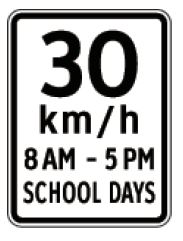First time I missed a 30 km/h in a school zone. I drove over the speed limit and failed. –SPEEDING
The second time I missed seeing a pedestrian entering a crosswalk. The pedestrian was behind the steel beam that held up the roof of my car. –DANGEROUS ACTION
The third time I did a three-point turn and drove off the paved portion of the roadway onto the edge of the grass of a neighbour’s front yard. –LEAVING THE ROAD SYSTEM
FAILING IS OUR GREATEST TEACHER – sadly
COOPER asks the driver the following questions:
- Q: Did you see the 30-speed sign?
- A: No
- Q: Did you see the pedestrian approaching the crosswalk?
- A: No
- EXPLANATION: You are not using your vision correctly. Missing fundamental laws, rules, signage, and vulnerable road users reveal zero forward scanning. Thirty zones and pedestrian crosswalks are well marked, and when you ignore them or miss seeing them, you can cause horrifying tragic injury!. A correction is needed – a more extensive and faster visual scanning pattern.
ISSUE#1: The answer is a more extensive and faster visual scanning pattern which must become a new habit. This new habit solves missing the 30 and the pedestrian. Scanning just ahead of the car does not work. This replacement skill takes time to fix.
- Q: Did you see the private property edge when you drove the 3-point turn?
- A: Yes
- Q: Then why did you drive off the road and onto the grass?
- A: I wanted more space to turn around in the 3-point turn. If I had stopped before going up on the grass edge, I would need to do a 4-point turn.
- EXPLANATION: A 3 point can also be 4 points or 5 points or more, depending on the width of the road. 3 point does not mean it has to be 3. It can be 3, 4 or 5 plus. Do not drive off the roadway onto sidewalks, curbs, grass or private property. Part of this driver’s issue was not knowing the rules related to this maneuver and erroneously thinking a maximum of 3 moves.
ISSUE#2: The answer here is practice, practice and practice. Turning a car around in tight places involves reversing, u-turns, 2-point turns, 3-point turns, stall parks, and parallel parks. This requires dozens and dozens of quiet-time repetitions for the learner’s brain to adapt to a SLOW–CALM – ABLE TO DO WHATEVER IT TAKES to position the car safely. Perfection is NOT the goal. Not hitting any object, the curbs, or driving off the road IS THE GOAL. Also, learn the 3-point rule, which can be 4, 5, 6 or more depending on available space.
Q: What will this practice teach the driver’s brain?
A: Both vision and feel will improve. Visually the driver will learn to judge the distances between the car and the road edge by looking inside the vehicle from the driver’s seat. Repeating this process will teach the brain where close is and how far away it is. Over time you will KNOW how to position the car anywhere you want. Feelings through your feet and the car tires as you gently touch the curb repeatedly will also help improve.
GOAL – GET OUT AND LOOK
To speed up this learning, you can regularly stop dozens of times, guess the distance to the edge of the line or the parked car from inside, and then GOAL – Get Out And Look/ This builds rock-solid confidence.
AHA MOMENT
And let the driver repeat these movements as many times as they need until you hear the words, inspiring words come out of their mouth, “I GOT IT! I GOT IT!”
CO-DRIVER RESEARCH
This co-driver was a parent, a police officer, an RCMP officer, a motorbike driver, a truck driver, and a very experienced driver. This driver was highly skilled, just like a very professional driver with a high degree of control demonstrated with smooth, accurate car positioning, gas, brakes and steering.
This new driver had many hours of practice with their co-pilot, driving several cars and trucks. I guess they operated like the very experienced driver, imitating their behaviours, but failed to do the vigilant visual searches required to drive low-risk. There was a sense of overconfidence mixed with confusion in the driver. We are great at copying others, however.
Imitation only goes so far. A proper understanding and experience are needed to master this driving craft. Overconfidence can blind a driver from the reality that mistakes happen and that there are always strange things and situations you may never have seen before.
Overconfidence often erases an eagerness to hunt for tricky situations and, at times, can cause drivers to relax too much as they forget to be vigilant, especially with their vision.
Multiple times working with other instructors, I have heard these words,
“I am a great instructor. I know everything so well now that I will never crash again.”
This thinking is a big illusion. The truth is, we all face risks every time we drive. The chain of events and the social connections driving requires that YOU DO NOT CONTROL all the risks. Every time I heard this instructor line, they would crash within a few weeks of BELIEVING they were PERFECT!!!!! Do not think this way! Overconfidence is a great danger.
Note here that a family connection results in a highly biased viewpoint. It’s called love. Love is why I DO NOT TRAIN ANYONE I KNOW!
Training your new driver to copy your movements has some value while learning; however, you must never forget that the new driver lacks many skills a 20-year driver has. Your vast experience and thousands of hours of repetition have helped your body and mind develop a very sophisticated series of skills WHICH THE NEW DRIVER DOES NOT HAVE!
—————–
My loving family members are intelligent, wise, and great drivers. Of course, they are! All of them!
Oh Really!
Be careful here!





Comments are closed